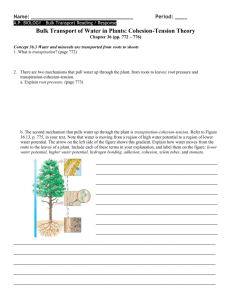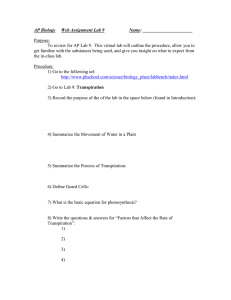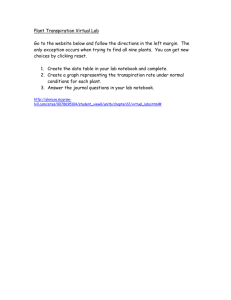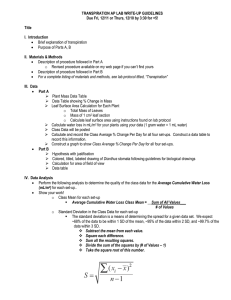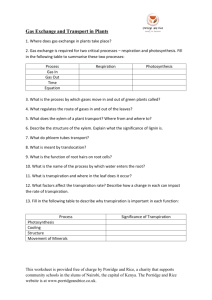Where does the water go?
advertisement
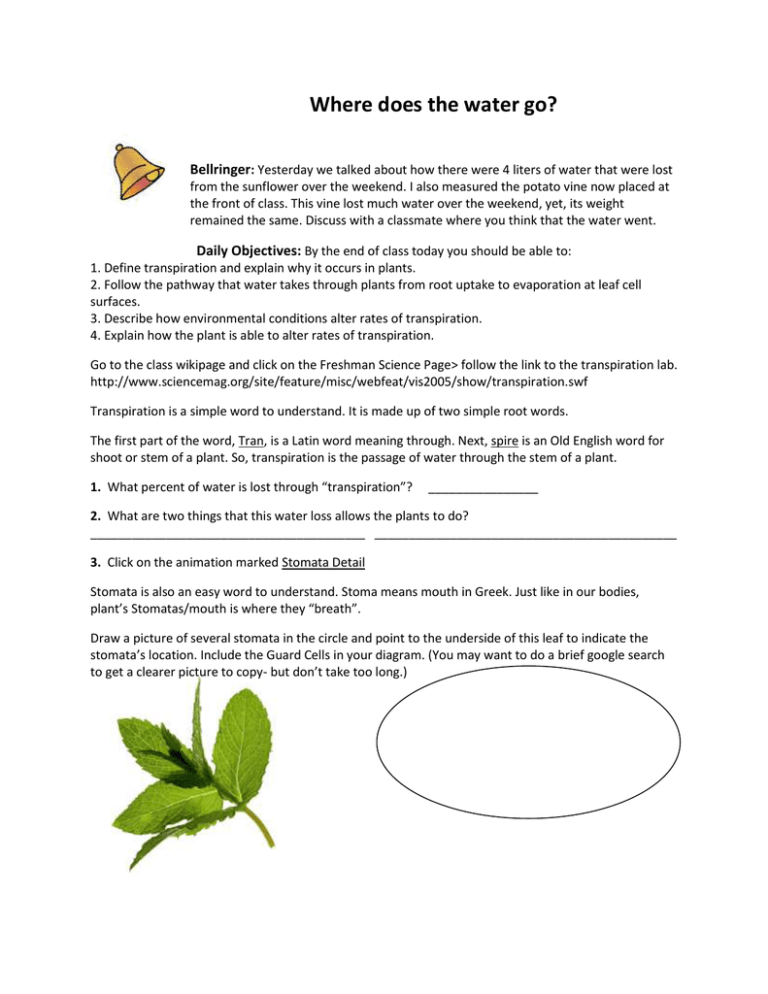
Where does the water go? Bellringer: Yesterday we talked about how there were 4 liters of water that were lost from the sunflower over the weekend. I also measured the potato vine now placed at the front of class. This vine lost much water over the weekend, yet, its weight remained the same. Discuss with a classmate where you think that the water went. Daily Objectives: By the end of class today you should be able to: 1. Define transpiration and explain why it occurs in plants. 2. Follow the pathway that water takes through plants from root uptake to evaporation at leaf cell surfaces. 3. Describe how environmental conditions alter rates of transpiration. 4. Explain how the plant is able to alter rates of transpiration. Go to the class wikipage and click on the Freshman Science Page> follow the link to the transpiration lab. http://www.sciencemag.org/site/feature/misc/webfeat/vis2005/show/transpiration.swf Transpiration is a simple word to understand. It is made up of two simple root words. The first part of the word, Tran, is a Latin word meaning through. Next, spire is an Old English word for shoot or stem of a plant. So, transpiration is the passage of water through the stem of a plant. 1. What percent of water is lost through “transpiration”? ________________ 2. What are two things that this water loss allows the plants to do? ________________________________________ ____________________________________________ 3. Click on the animation marked Stomata Detail Stomata is also an easy word to understand. Stoma means mouth in Greek. Just like in our bodies, plant’s Stomatas/mouth is where they “breath”. Draw a picture of several stomata in the circle and point to the underside of this leaf to indicate the stomata’s location. Include the Guard Cells in your diagram. (You may want to do a brief google search to get a clearer picture to copy- but don’t take too long.) 4. Why would a plant have stomata on only one side of their leaves? ____________________________ 5. Note how each water molecule that leaves the stomata pulls an additional water molecule closer to the “mouth” of this plant. In chemistry this is called a Chemical _____________________. It is what holds together two atoms or two molecules (a molecule is made of several atoms). 6. Water is a molecule (Y/N) _________ 7.Hydrogen is a molecule (Y/N) __________________ 8. Under the close-up of the stomata click on the button> Top. Look at how the water is leaving the leaves. Open and close the Stomata. Describe how the plant changes to stop water from evaporating? (2pts) _____________________________________________________________________________________ _____________________________________________________________________________________ 9. Why would a plant close its stomata? (2pts) _____________________________________________________________________________________ _____________________________________________________________________________________ 10. Why would cacti have very few Stomata? (2pts) _____________________________________________________________________________________ _____________________________________________________________________________________ 11. Exit this animation and click on the xylem animation. Xylem is not an easy word to remember. It is the name of the inside of a plants trunk. If you have ever cut down a Christmas tree this is the hardwood that is at the very center. Using the information you have, describe what the xylem does and how. (5pts) _____________________________________________________________________________________ _____________________________________________________________________________________ _____________________________________________________________________________________ _____________________________________________________________________________________ 12. Draw a plant on the back page of this exercise. Diagram the passage of water from the beginning to the end. Label all three sites of the process. 13.( 3pts) Exit this animation and click on the root animation. Water enters the plant at its ____________ then travels up through the ______________ then it exits out the plants _____________ on the leaves. 14. Now, click on the bottom part of the main animation where it says cuticle. This is the same word as the skin that covers over your fingernails. A cuticle is a waxy type of skin. Some desert-like plants like the ones I have in my room have a very thick cuticle. (2pts) This thick cuticle causes (More/Less)____________ transpiration, and therefore, (More/Less) ________ water loss from the plants. 15. Can you think of anyways that our Coleus plants have increased their boundary layer? (+ 2) __________________________________________________________________________________. 16. Based on what you know predict whether the following external environment would increase or decrease the rate of transpiration before you click on the links. *** The external environment will affect the plant. The effect of this will be a change in the rate of transpiration.*** (1pt) Environmental Change (affecting plant) Humidity (Increase or decrease in transpiration) final effect Increased Light Wind Cool Air 17. Were you right? What do scientists predict the actual response will be? (4pts) Environmental Change (affecting plant) Humidity (Increase or decrease in transpiration) final effect Increased Light Wind Cool Air I hope you have learned something today. Tomorrow we will grade this “Virtual Lab”. Remember, once I have my grades entered in I will not take any late-work. This is my policy. If you cannot get all the way through this worksheet please find the time to finish it before tomorrow. -If you want to use the library again ask Sandy…. (KINDLY ASK SANDY!!! –she is someone who you want to be your friend) if/how you can do that during your clubs today. - Mr. Smalley


